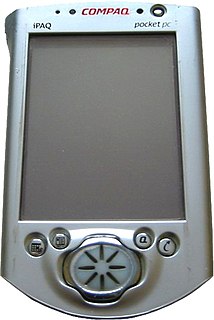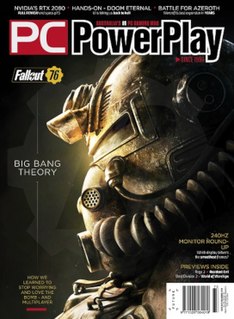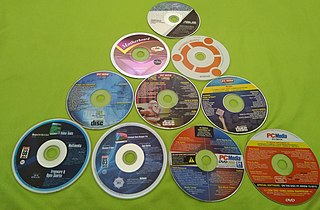Related Research Articles

In computing, BIOS ; an acronym for Basic Input/Output System and also known as the System BIOS, ROM BIOS or PC BIOS) is firmware used to perform hardware initialization during the booting process, and to provide runtime services for operating systems and programs. The BIOS firmware comes pre-installed on a personal computer's system board, and it is the first software to run when powered on. The name originates from the Basic Input/Output System used in the CP/M operating system in 1975. The BIOS originally proprietary to the IBM PC has been reverse engineered by some companies looking to create compatible systems. The interface of that original system serves as a de facto standard.
ISO 9660 is a file system for optical disc media. Being sold by the International Organization for Standardization (ISO) the file system is considered an international technical standard. Since the specification is available for anybody to purchase, implementations have been written for many operating systems.

The Compact Disc-Interactive is a digital optical disc data storage format that was mostly developed and marketed by Dutch company Philips. It was created as an extension of CDDA and CD-ROM and specified in the Green Book, co-developed by Philips and Sony, to combine audio, text and graphics. The two companies initially expected to impact the education/training, point of sale, and home entertainment industries, but CD-i eventually became best known for its video games.

In computing, booting is the process of starting a computer. It can be initiated by hardware such as a button press, or by a software command. After it is switched on, a computer's central processing unit (CPU) has no software in its main memory, so some process must load software into memory before it can be executed. This may be done by hardware or firmware in the CPU, or by a separate processor in the computer system.

A Pocket PC is a class of personal digital assistant (PDA) that runs the Windows Mobile or Windows Embedded Compact operating system that has some of the abilities of modern desktop PCs. The name was introduced by Microsoft in 2000 as a rebranding of the Palm-size PC category. Some of these devices also had integrated phone and data capabilities, which were called Pocket PC Phone Edition or simply "Smartphone".
A disk image, in computing, is a computer file containing the contents and structure of a disk volume or of an entire data storage device, such as a hard disk drive, tape drive, floppy disk, optical disc, or USB flash drive. A disk image is usually made by creating a sector-by-sector copy of the source medium, thereby perfectly replicating the structure and contents of a storage device independent of the file system. Depending on the disk image format, a disk image may span one or more computer files.

A live CD is a complete bootable computer installation including operating system which runs directly from a CD-ROM or similar storage device into a computer's memory, rather than loading from a hard disk drive. A Live CD allows users to run an operating system for any purpose without installing it or making any changes to the computer's configuration. Live CDs can run on a computer without secondary storage, such as a hard disk drive, or with a corrupted hard disk drive or file system, allowing data recovery.

The FM Towns Marty is a fifth-generation home video game console released in 1993 by Fujitsu, exclusively for the Japanese market. It is often claimed to be the first 32-bit CD-based home video game system, although it has a 16-bit data bus, just like the earlier Commodore CDTV and Sega CD, which both have Motorola 68000 processors that is similarly internally 32-bit, but with a 16-bit data bus. The console came complete with a built in CD-ROM drive and disk drive. It was based on the earlier FM Towns computer system Fujitsu had released in 1989. The Marty was backward-compatible with older FM Towns games.

PC PowerPlay (PCPP) is Australia's only dedicated PC games magazine. PC PowerPlay focuses on news and reviews for upcoming and newly released games on the Microsoft Windows platform. The magazine also reviews computer hardware for use on gaming computers. The magazine is published by Future Australia.
PC Format was a computer magazine published in the United Kingdom by Future plc, and licensed to other publishers in countries around the world. In publication between 1991 and 2015, it was part of Future plc's Format series of magazines that include articles about games, entertainment and how to get the most out of the platform. Despite the occasional mention of alternatives, PC Format takes the term 'PC' to mean a Microsoft Windows-based computer.

Copy Control was the generic name of a copy prevention system, used from 2001 until 2006 on several digital audio disc releases by EMI Group and Sony BMG Music Entertainment in several regions. It should not be confused with the CopyControl computer software copy protection system introduced by Microcosm Ltd in 1989.
SafeDisc is a copy protection program for Microsoft Windows applications and games distributed on optical disc. Created by Macrovision Corporation, it was aimed to hinder unauthorized disc duplication. The program was first introduced in 1998 and was discontinued on March 31, 2009.

MediaMax CD-3 is a software package created by SunnComm which was sold as a form of copy protection for compact discs. It was used by the record label RCA Records/BMG, and targets both Microsoft Windows and Mac OS X. Elected officials and computer security experts regard the software as a form of malware since its purpose is to intercept and inhibit normal computer operation without the user's authorization. MediaMax received media attention in late 2005 in fallout from the Sony XCP copy protection scandal.

Covermount is the name given to storage media or other products packaged as part of a magazine or newspaper. The name comes from the method of packaging; the media or product is placed in a transparent plastic sleeve and mounted on the cover of the magazine with adhesive tape or glue.

Personal Computer World (PCW) was the first British computer magazine. Although for at least the last decade it contained a high proportion of Windows PC content, the magazine's title was not intended as a specific reference to this. At its inception in 1978 'personal computer' was still a generic term The magazine came out before the Wintel platform existed; the original IBM PC itself was introduced in 1981. Similarly, the magazine was unrelated to the Amstrad PCW.

The terms Recovery disc, Rescue Disk/Disc and Emergency Disk all refer to a capability to boot from an external device, possibly a thumb drive, that includes a self-running operating system: the ability to be a boot disk/Disc that runs independent of an internal hard drive that may be failing, or for some other reason is not the operating system to be run.
Resource Kit is a term used by Microsoft for a set of software resources and documentation released for their software products, but which is not part of that product. Resource kits offer supplementary resources such as technical guidance, compatibility and troubleshooting information, management, support, maintenance and deployment guides and multipurpose useful administrative utilities, which are available separately.

Microsoft PowerToys is a set of freeware system utilities designed for power users developed by Microsoft for use on the Windows operating system. These programs add or change features to maximize productivity or add more customization. PowerToys are available for Windows 95, Windows XP, and Windows 10. The PowerToys for Windows 10 are free and open-source software licensed under the MIT License and hosted on GitHub.

Microsoft Encarta was a digital multimedia encyclopedia published by Microsoft Corporation from 1993 to 2009. Originally sold on CD-ROM or DVD, it was also available on the World Wide Web via an annual subscription, although later articles could also be viewed for free online with advertisements. By 2008, the complete English version, Encarta Premium, consisted of more than 62,000 articles, numerous photos and illustrations, music clips, videos, interactive content, timelines, maps, atlases and homework tools.
References
- ↑ CAT2003-Cover-IFC-p1.OK Archived 11 October 2007 at the Wayback Machine
- ↑ "pcace.co.uk". Archived from the original on 13 June 2001. Retrieved 2016-12-01.CS1 maint: discouraged parameter (link) CS1 maint: bot: original URL status unknown (link)